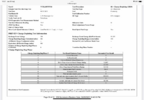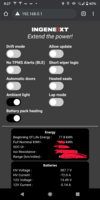For those that are able to get the the nominal and buffer, perhaps allowing those users to type in the values for now until there is a way via the API could work as a stop gap measure.
I finally got Scan My Tesla installed on my 2023 MYLR and it is showing 78.7kWh for the nominal full pack which differs only slightly from the 78.5kWh that Tessie defaults to, so I corrected that. Looks like that's apples-to-apples (includes buffer) so that's good.
Now Tessie is showing 0.1% degradation, with about 4,500mi since Feb 2023.
The battery pack in your MY LR is marked 82.1 kWh Full Pack when New.
The EPA test of the MY LR 2023 (was actually made on a 2022 as per the test certification), gave an output of 80.7kWh. The MYP (same battery did output 81.05kWh. There are some EPA tests where this battery type did actually deliver 82.1 (82.07kWh).
But as a start, they deliver about 81kWh on cars for the EPA test, which is ”broken in” by use, this 2022 MYLR was driven 4000miles Before the test. A completely new might deliver slightly more.

The 330 miles EPA range set the demand of the delivered capacity to slightly above 79kWh, somewhere around 79.1-79.2kWh. We find the same number on the M3LR with the same pack.
How to set the starting value can be discussed (huhh)….either the marked ”Full Pack When New” or the about 80.7 to 81kWh delivered in the EPA test, or the minimum energy needed to actually make the EPA range the car was sold with.
330 miles EPA range needs about 79.1-79.2kWh, there’s probably someone that have the exact number on that.
@AlanSubie4Life maybe?
Any initial capacity below that 79.2 (-ish) will not cover the specified range. The cars normally start with a higher capacity, and the rated miles have a larger energy content when the battery has a higher capacity so the range doesnt go higher than 330.
I can see 79.2, but not lower as the initial capacity, or 80.7-81 or 82.1 KWh.
Inside the Tessie battery meter it should say 79.2 (at least) to cover the range the car was sold with.
Is that the best estimate possible without doing a full drain/charge test via service menu?
The battery test seem to have shown strange results from what I read so in that case, better to believe the nominal full pack value, even if it can be off track sometimes. Or do as I did last summer, charge full and drive to 0% (use Scan my tesla to hit 0% as close as possible), and after checking the SOC a while after the drive you can use the used energy and divide by 0.955 to get the total capacity including the buffer. Do not drive very fast as heat losses will take some “invisible energy” from the equation. 55mph or slower might be good.




